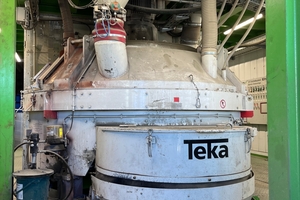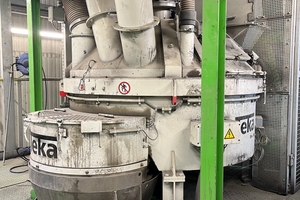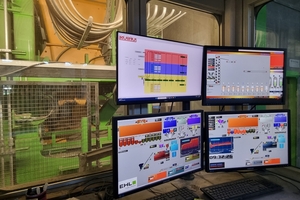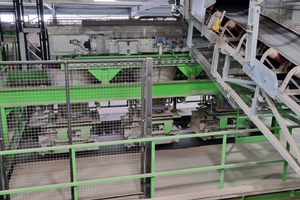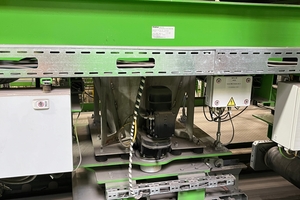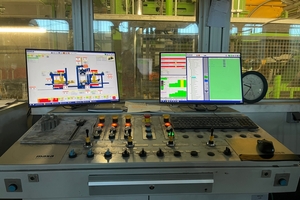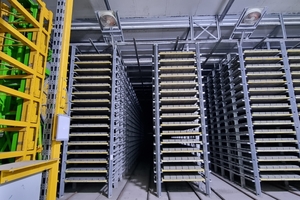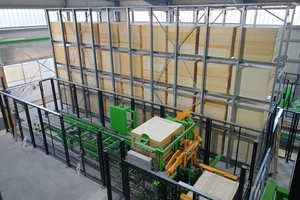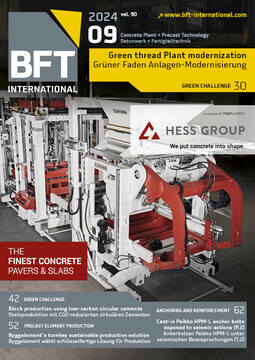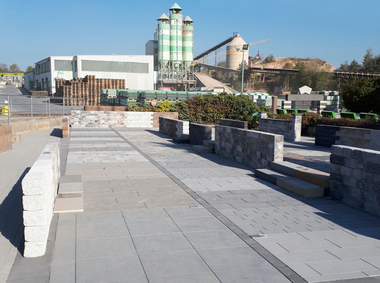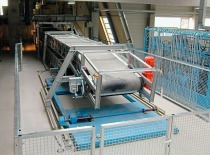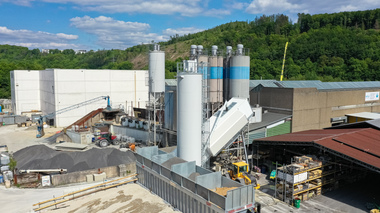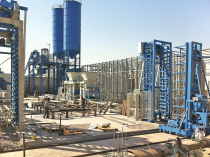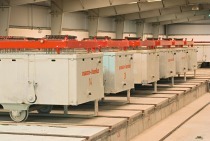Green thread Plant modernisation: Success with future-proof and sustainable strategies
Ehl AG, a CRH Group company, is one of the leading concrete block and paver manufacturers with more than 40 years of market experience and a network of over 20 locations in Germany. After extensive modernisation, the company‘s most modern plant is now located in Wittenburg.
Ehl‘s corporate colour is “Green” – a colour that is not exclusive to the company‘s corporate design. Green is also the company‘s commitment to sustainable development. With a business unit set up specifically for quality and the environment. For example, Ehl relies on production with energy-saving machines, responsible use of resources and continuous optimisation of recipes. Or on sustainable modernisation strategies, such as at the Wittenburg plant.
The northernmost Ehl site is located around 80 kilometres from Hamburg and has been producing pavers, patio slabs, walling systems and other products for gardening and landscaping since 2004. The sales area is large: from the Baltic Sea to the area between Hamburg and Flensburg, the company serves a wide range of customer structures from building contractors and hardware stores to specialist retailers with growing demands for variety and quality. Ehl was only able to fulfil these requirements to a limited extent with the existing plant. After comprehensive market analyses, the company finally discarded the original concept of „only“ installing a second, more efficient production machine in Wittenburg and instead invested on a large scale: according to its own information, Wittenburg now has a completely modernised block and paver production plant with the most modern technology in the company. Looking back, it is clear to see how much the „green thread“ runs through the entire project: The concept of sustainability influenced the planning and realisation of the plant modernisation in many respects.
Sustainability at Ehl
Sustainability always encompasses several dimensions. The aim is to achieve ecological, social and economic goals. In general terms, this means for Ehl in the area of concrete block and paver production, for example:
The concrete products are developed with foresight in order to keep the cement content of the products as low as possible while maintaining the same quality and durability. The used cement is particularly low in CO2.
The concrete products are produced in an energy-efficient manner.
Concrete left over from production is recycled: the concrete is crushed and reused for aggregates.
The company focuses on minimising transport routes: On the one hand, the natural raw materials used are mostly sourced from the vicinity of the company‘s own concrete plants. On the other hand, the widespread distribution of sites throughout Germany guarantees short distances for the end products from the concrete plant to the customer.
The packaging of the concrete blocks and pavers required to secure the pallet load and protect them from dirt and moisture is reduced to a minimum. At the same time, Ehl uses biodegradable eco-granulate between the individual product layers to protect the sensitive surfaces.
Most of the Ehl concrete block pavers and slabs can be laid in an ecological bond so that surfaces remain water-permeable and rainwater can seep away.
Safety has top priority. The list of measures for employees, partners and customers is long. It includes, for example, detailed safety instructions and occupational safety measures for everyone who enters the plants, plant security in accordance with the LTT system (lock out, tag out, try out) and safety guidelines for all partners and customers. The success of these measures is recognised by the „Safety Award“ presented by the parent company CRH and the „Sicher mit System“ seal of approval awarded by the Berufsgenossenschaft Handel und Warenlogistik.
With a specific view to the extensive modernisation project in Wittenburg, there were further opportunities to act sustainably. Special solutions had to be developed in advance that were completely tailored to Ehl and included a highly customised plant layout. No easy task for a project team that could only succeed because reliable and, above all, binding business partners were on board.
Careful supplier selection
For Ehl, it is clear that when selecting business partners, only those companies are considered that can present and implement a coherent overall concept, keep promises in terms of content and deadlines and offer competent and available contact persons.
When forming the Wittenburg team, which had to work closely together on this highly complex project over a period of several months, Ehl opted for business partners who had already been working together successfully on a number of such projects in Germany and abroad for many years: Ehl named Masa GmbH as the main supplier for the new production technology, including control of the ring plant. The contract for the mixing technology was awarded to Teka Maschinenbau GmbH. Ehl entrusted the separate control of the dosing and mixing area to Sauter GmbH.
Ehl also deliberately placed the other tasks in the hands of long-standing business partners: Rotho - Robert Thomas Metall- und Elektrowerke GmbH & Co. KG (chamber system), Kaiser Ingenieurbau GmbH (hall conversions), the architecture firm Burkhardt (civil engineering, buildings, approval procedures) and other local companies met expectations in full.
During the assembly phase, the project participants regularly exchanged information about the current status quo in order to achieve the overarching goals together. Ehl moderated the weekly jour fixe, in which the upcoming activities were proactively discussed and the teams‘ respective efforts were coordinated. The intensive communication paid off: the plant in Wittenburg is the reference plant for Ehl and reliably supplies customers with high-quality and innovative concrete products.
There is no question that the success of the site is the sum of many individual factors. In the following, only a few aspects of the project will be discussed in more detail – with a specific focus on the plant design and machine technology. Two sub-areas with scope for sustainability.
Focus I: The plant design
The guiding principle of „sustainability“ had a decisive influence on the basic design of the new facility. On the one hand, the existing hall in Wittenburg was only to be extended as far as necessary. On the other hand – with a view to possible future market development – ways were to be left open for further investments, for example in the silo system or the dry side. At the same time, Ehl expected a plant orientated towards the demanding CRH safety concept, which would offer the opportunity to reinvent products.
The plant concept, which took into account both the conditions on site (construction in existing buildings) and the aspects of diversity, efficiency and safety of the new plant, covered several points:
Successful integration and expansion of existing areas
Although a large part of the existing machine technology had to be replaced with new components during the modernisation of the Wittenburg site, parts worth keeping were incorporated into the new plant concept as far as possible. For example, the existing, still well-preserved chamber system was not dismantled but extended and now offers around a third more capacity. Another sustainable feature is that the new Masa block making machine is compatible with the entire Ehl mould pool used across all sites. This enables moulds to be exchanged throughout Germany because every block and paver making machine in the Ehl plants uses the same compaction head locking system to fix the upper part of the mould (= compaction head) to the machine‘s compaction head fastening plate.
Measures on the way to the zero-waste concept
„Waste“ not only costs money, but is also ineffective. On the way to a resource-conserving and waste-avoiding concept, Ehl has made a conscious decision in favour of high-priced, but also energy- and material-efficient machine technology throughout the entire production process. A high degree of efficiency in material utilisation goes hand in hand with fewer rejects and therefore less waste.
If there are still rejects, Ehl recycles them and reuses them as raw materials for concrete production, among other things. To realise this idea, Masa integrated a tilting device downstream of the Masa QA system on the wet side. Products that do not meet the quality requirements can be sorted out before curing and fed into the recycling process.
In line with the zero-waste concept, the procurement of electric forklift trucks is another example.
Realisation of a customised security concept
Both Masa and Ehl always saw this concept as an extensive process in which various drafts were discussed, rejected or finalised. A key aspect: The employees on site were involved in the concept, which resulted in a high level of acceptance for the individual measures right from the start. The result is a plant with a safety concept that has been thought through down to the last detail and offers very safe working conditions while still providing very convenient access to the individual components and production areas.
One example is the Masa QA system with Offset inspection station on the wet side. At the request of the plant operator, the system ejects the production board for inspection/QA measures into a safe area accessible from two sides. As the block making machine can continue production without interruption during these checks, the plant personnel have enough time to carry out more extensive checks.
Delivery of a plant with optimised energy efficiency
For Ehl, achieving high productivity always goes hand in hand with high energy efficiency. In concrete terms, this meant that the expectations in Wittenburg were that the ratio of plant output to energy input should be significantly better compared to the old plant. The positive result achieved in Wittenburg is due, among other things, to the use of a wide variety of components and their interaction with the plant control system. This is reflected in Masa‘s scope of delivery as well as that of other project partners such as Teka or Sauter:
Replacing hydraulic and pneumatic functions as far as possible with more energy-efficient electric drive systems. Where this is not possible, speed- and pressure-controllable valve units are used.
Use of servo-controlled drives as the most energy-efficient and precise method of controlling motors
Partial use of synchronous servomotors
Use of multi-axis systems in the DC link to utilise braking energy, reduce heat loss and reduce or avoid braking resistances
Use of harmonic movements with optimum path-time diagram, e.g. for packaging
Reduction of peak currents
Optimised production processes through the use of suitable sensors
Realisation of shorter throughput times in the curing plant area thanks to a chamber climate optimised by Rotho
Optimised and product-specific operation of each plant section thanks to recipe-based plant control and the option of individual parameter settings.
Focus II: Machine technology
Product variety, flexibility, quality and quantity – compared to the previous production plant in Wittenburg, the new plant should be a real quantum leap for Ehl, especially in these areas. The essential levers for this can be found in the following plant areas, among others:
Mixing area,
Multi-colour system,
Production machine,
Curing,
Handling area.
Efficient technology and control for the mixing area
At the very beginning of the production process, the mixing technology in combination with a flexible supply of aggregates, binding agents and additives plays an important role, which was taken into account in the new plant design for Wittenburg.
On the one hand, the plant now has space for up to 16 different aggregates, four different binders and additives such as pigments or fly ash, which are now added, weighed and dosed separately for the main and face mix concrete. This new design enables Ehl to produce pure aggregates without any possible contamination of the main and face mix.
Secondly, the actual mixing area was completely modernised. Here, Ehl relied on its long-standing partner Teka, with whom many other projects had already been successfully realised throughout Germany. The main aim was to fulfil the demand for variety and flexibility, which applied equally to the main and face mix concrete.
Teka therefore recommended the use of turbine mixers for both areas, especially as the main mix concrete should also be produced partially coloured (e.g. for splitted or aged pavers that are fully coloured). Each Teka turbine mixer is customised to individual requirements and specified according to the specific mixing task. The drive power, the diameter of the mixing trough and the number of mixing turbines are variable and are specially selected for each individual mixing task.
The THT 3000 high-performance turbine mixer (type J-3-VII) with a frequency-controlled 75 kW drive motor and a maximum concrete output of 2.0 m³ is used in Wittenburg to produce the main mix concrete. The mixer has a carbide-coated, patented mixing turbine and two counter-rotating mixing stars. These ensure very intensive mixing of the batch while at the same time protecting the grain, so that the grading curve remains unchanged. The mixing star and the clearing and scraper blades, which also rotate, continuously feed material to the counter-rotating mixing turbine. The system thus achieves very intensive and rapid mixing of the material, a very high degree of homogenisation, optimum mixing of the feed water and an almost straight measuring curve for moisture measurement. Both mixing stars and the mixing turbine also rotate on different working circuits, so that optimum mixing is achieved due to the multiple coverage of the trough floor.
The THT 600 mixer (type E-1-III) produces the face mix concrete with a high proportion of fine grains and high-quality aggregates at an output of 0.4 m³ per mix. The decisive advantage of the turbine mixer with patented mixing turbine is that the entire range of filling quantities, right down to the smallest quantities, can be utilised with a high degree of variability without any loss of quality. The mixing turbine can process both liquid and dry concrete. In combination with the mixing turbine, an oversized discharge opening ensures complete emptying in a very short time – a point that plays a significant role when changing products. With the THT 600, Ehl has thus received a very fast mixer for realising frequent product and colour changes within the high-quality product range.
The deliberately low number of mixing tools and the associated number of adhesion points as well as a separate scraper for the mixing turbine result in low cleaning requirements with long cleaning intervals and minimised cleaning times for both mixers. This is a sustainable approach because Teka not only reduces the time and costs involved, but also the impact on plant personnel and the environment.
The complete dosing and mixing area requires a process control system with high efficiency and dosing accuracy. Ehl had already had very good experience with Sauter mixing plant control systems at many other locations. It was therefore an obvious choice to commission Sauter to develop and implement the control system, the visualisation including visualisation splitting, the control cabinets and the electrical installation in Wittenburg as well.
The Sauter s-mix process control system with integrated database centrally controls all plant components of the dosing and mixing plant. It offers full visualisation of the entire area and enables the mixing plant to be operated from all workstations. The Sauter s-systems can be flexibly customised to individual requirements and enable highly accurate dosing of all components to ensure consistent quality and consistency of the concrete.
A very important factor here is the right amount of water. This is why the Sauter s-systems use innovative measurement technology that reliably detects even the smallest fluctuations in the water quantity: Moisture is measured using Sauter microwave sensors in the core and face mixer and capacitive sensors in the aggregate silos. The fully automatic s-visco water dosing system compensates for these fluctuations.
Creating exclusivity with the multi-colour system
Ehl concrete products are designed to create places of well-being, to be figureheads around the home, to help structure gardens, to set visual highlights. And be as exclusive as possible. In addition to the actual block and paver making machine, a further, highly efficient system component is required to achieve this goal: A multi-colour system with maximum reproducibility of the products - at any time, on any production base.
For Ehl, the patented multi-colour system from Masa had precisely this advantage to offer. Masa put a lot of passion, experience and knowledge into the design of this system, which is available in different versions for both main and face mix concrete. Precisely dimensioned to meet the requirements in Wittenburg, the system consists of a silo unit with three storage silos and silo vibrators, three swivel units with dosing belts, a collecting belt positioned under the silo unit and a separate page in the Masa visualisation program.
Masa takes reproducibility into account with a striking module in the recipe management of the products: up to 10 concrete placement sequences can be defined for each product. A sequence always defines three parameters per silo:
the exact placement position of the concrete on the collecting belt, which can be controlled via swivelling dosing belts. The collecting belt itself can be moved and is equipped with a frequency converter for speed adjustment, so that the concrete can be fed into the machine silo precisely and, above all, evenly.
the delay time, which determines the time at which dosing onto the collecting belt should begin. Depending on the set time, the desired concrete overlays are possible.
the quantity of concrete to be dosed, which is regulated via the running time of the dosing belt. The running time is largely defined by the weight factor (kg/s), which is set in sequence.
In order to continuously and efficiently achieve the best colour results on each individual layer, unwanted changes in the colour or consistency of the concrete must be minimised. For this reason, each silo only stores one colour at a time to ensure colour purity. Adhesions are a critical factor that can lead to a loss of quality and increased cleaning effort. Masa counteracts the risk of material build-up, which could later lead to contamination of the fresh concrete with older concrete residues, by using stainless steel storage silos.
To ensure that unavoidable cleaning processes can still be carried out quickly and safely, each silo has a cleaning access point. The monitoring of the fill level values for a full signal, concrete request, tilt release and empty signal is carried out via load cells on which each silo is suspended. Masa thus offers a clean and low-maintenance solution for fill level detection that completely dispenses with probes or lasers inside the silos.
To protect the dosing belt drives, each silo is decoupled from the swivelling unit via rubber buffers. The vibrations caused by the silo shakers are therefore not transmitted to the drives.
Plus point servo technology: The production machine
In the run-up to the decision-making phase, Ehl already had a specific production machine in mind, the Masa XL-R 9.1. In the intensive discussions that followed, Ehl specified the performance requirements for the machine. It was clear to the customer that the machine had to be optimally designed for the requirements of gardening and landscaping as well as large-format products. Masa combined the already extensive standard equipment of the XL-R with further additional equipment. Examples include the scraper on the filling box for a clean and homogeneous surface, the smoothing roller for a closed, smooth surface, the oscillating grate with external guides for even filling, the servo-hydraulics for an even and precisely coordinated demoulding process and the cross cleaning device for a high level of cleanliness of the tamper head shoes.
Ehl also appreciated other advantages of the XL-R:
The very simple and individually adjustable servo vibration: The drive of the four vibration motors of the vibration unit is carried out in each case via cardan shaft with servo motor. The servo motors are synchronised via an axis control. By changing the phase position within a pair of vibrators (two vibrators each with opposite directions of rotation), vertical vibrations of different strengths can be generated at constant speed. This technology allows the vibration force to be adjusted during the production cycle regardless of the speed. The vibration can thus be optimised depending on the product, so that a uniform vibration input into the production board and into the product is ensured, and thus optimum filling and compaction is achieved.
The short cycle times: Masa realises a high production speed through intelligent drives, overlapping movements and a fast passage of the production boards through the machine, among other things. This in turn is achieved by the production board feed with hydraulically/electrically combined drive transporting an empty production board to the compaction unit, while at the same time a production board with finished products is transferred to the lowering device designed as a V-belt conveyor and from there to the wet side conveyor in one operation. The speed of the feed and the lowering device are synchronised. This means that the XL-R model series offers the shortest cycle times compared to the other Masa block and paver making machines.
The Masa automation applications: They support the plant personnel in intuitive operation and thus enable reliable plant performance. The modular software developed by Masa includes tools for visualisation, product management and production data acquisition, for example. A connected fault tool signals any faults that occur so that they can be localised and rectified quickly and precisely.
Uniform curing in the climate chamber
Freshly produced concrete products must undergo a curing process to achieve standardised strength, which usually takes place in chamber plants and is coordinated by appropriate storage and retrieval logistics. The existing Rotho chamber plant in Wittenburg was to continue to be used, but was to be expanded and modernised. For this purpose, Rotho designed the addition of five additional rack aisles as a free-standing building, which was attached to the outside of the existing chamber system.
In order to minimise power consumption (according to Rotho, power savings of up to 60 % can be achieved), the speed of the air circulation fans is controlled via a central frequency converter with sine filter according to the desired temperature deviation in the chamber. The speed control of the air circulation system achieves a very high level of efficiency.
As a rule, the heat of hydration generated during the curing process is completely sufficient and does not need to be artificially increased. This saves a lot of energy. Only when necessary, for example after a production stop, is the heating integrated into the air circulation system switched on to warm up the then cold chamber.
Flexible handling area with good access options
When designing the plant Ehl attached great importance to another area in terms of accessibility, flexibility and safety: the handling of the cured product layers through to the packaged product cubes ready for transport.
Masa also expertly integrated this sub-area into the complete plant layout. The planning of the required interaction between the dry side, layer shifter, layer remodelling unit, cubing, packaging stations and transport conveyors for finished product cubes as well as the intermediate storage and return of the empty production boards to the production machine was carried out meticulously and with room for future expansion options. Compared to the previous plant in Wittenburg, the entire area is now characterised by significantly better accessibility on one level and therefore also offers a significant increase in safety for the operating personnel.
In the remodelling area, a solution customised for Ehl stands out in particular. On the one hand, Masa reprogrammed the standard layer shifter so that it can double or triple layers without damaging the surface, thus achieving an even faster throughput time during subsequent cubing. Secondly, the pushing device of the remodelling unit has a layer detection function. If entire rows of stones, such as lawn edging, are sorted out, the system automatically corrects the layer size. Time-consuming manual sorting is no longer necessary. Insertion work in the cubing area is also automated. Here, a robot programmed by Masa and equipped with special gripper tools takes over the tasks in the safety area.
The transport area for the product cubes with roller conveyors and a cube turntable designed and realised by Masa now also takes into account the existing infrastructure of the external warehouse. The implementation of the shortest possible routes ensures fast accessibility and thus optimises the entire storage concept for the end products.
The Masa solution for the return and storage of empty production boards opens up individual, product-specific handling options and fully fulfils the Ehl requirement for high capacities. In this area, the empty production boards are handled by the Masa components Z-turner with collecting and turning function, transport conveyor I to IV, transport carriage with lifting mast and destacking device - all coordinated by the Masa control system. The Rotho board buffer in a special four-storey version offers the possibility to temporarily store up to 2,800 production boards in a space-saving manner.
Conclusion
The highly complex project in Wittenburg could only be realised thanks to the great commitment of all project partners involved. With the new plant, Ehl has invested in a modern and future-proof factory to serve the market from Hamburg to the Baltic Sea quickly, flexibly and efficiently with high-quality concrete products. With a green thread running through the individual areas of the plant – both visually and in terms of content. And which incorporates ecological, social and economic sustainability aspects in various dimensions of a concrete block and paver production plant. The use of energy-efficient technologies, the responsible use of resources and the implementation of high safety standards, while at the same time taking into account the increasing demands on quality and variety: Ehl is setting standards with the new plant.
CONTACT
EHL AG
Alter Wölzower Weg 6
19243 Wittenburg, Deutschland
T +49 33233 7250
Masa GmbH
Masa-Str. 2
56626 Andernach, Deutschland
T +49 2632 92920
TEKA Maschinenbau GmbH
In den Seewiesen 2
67480 Edenkoben, Deutschland
T +49 6323 8090
Sauter GmbH
Sauter GmbH
Untere Mühlewiesen 14
79793 Wutöschingen – Degernau, Deutschland
Tel.: +49 7746 92300
ROTHO - Robert Thomas Metall- und Elektrowerke GmbH & Co. KG
Hellerstraße 6
57290 Neunkirchen, Deutschland
T +49 2735 7880

